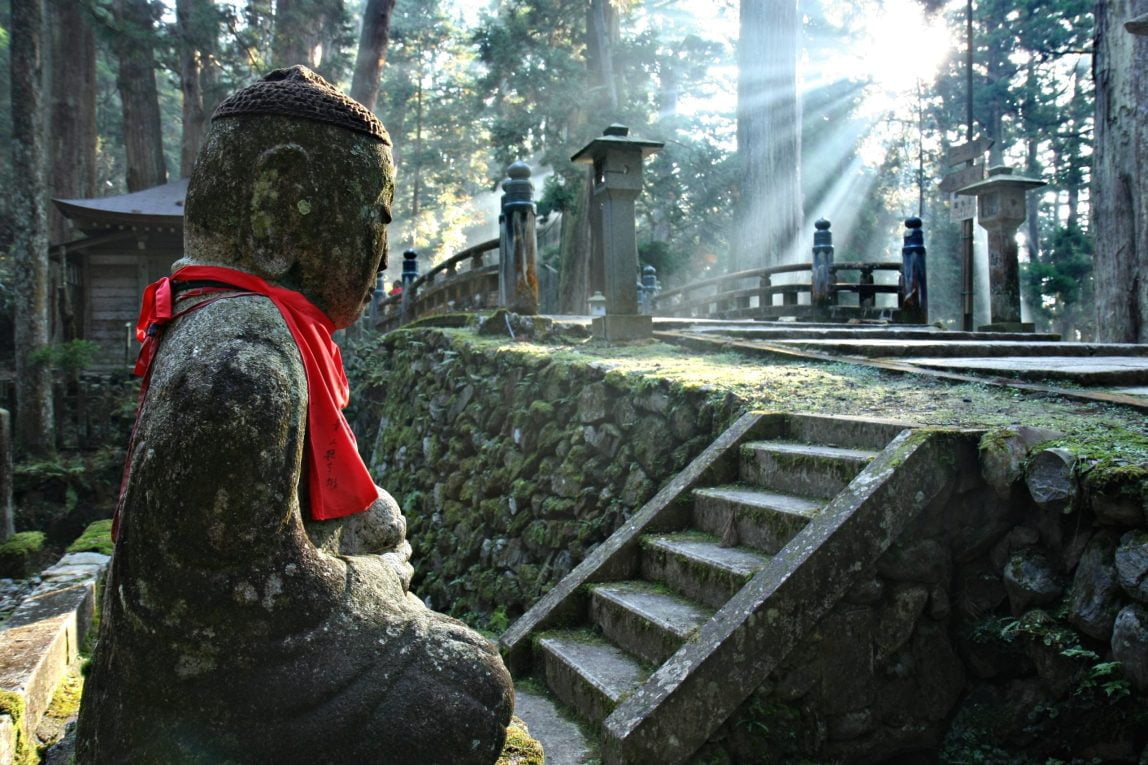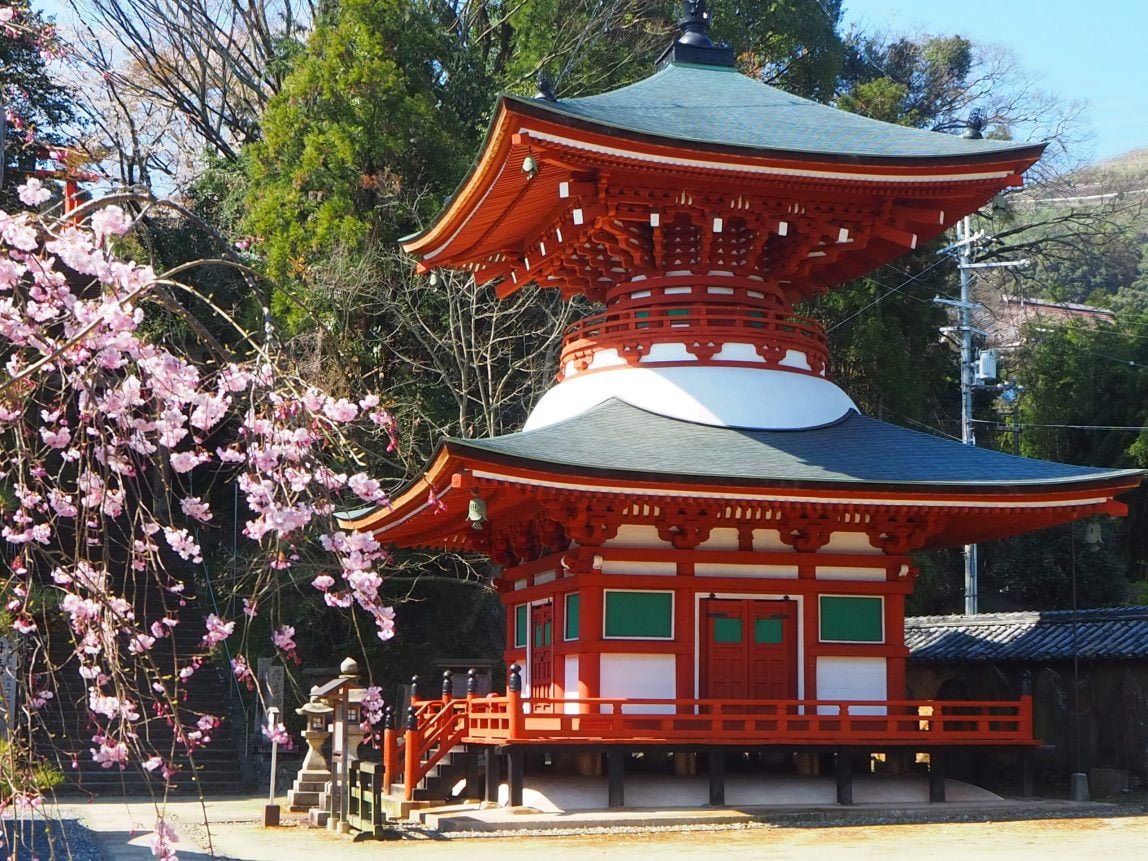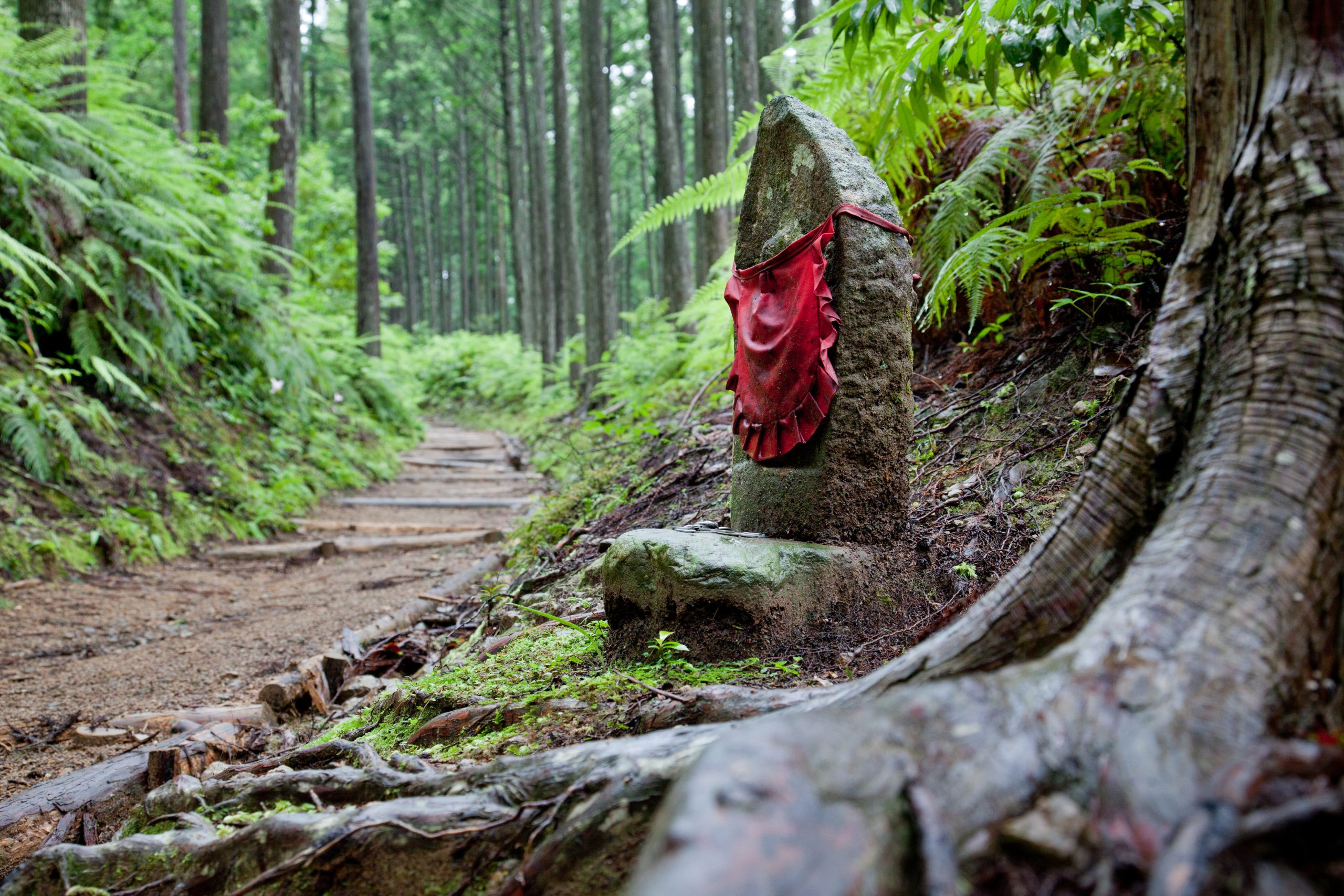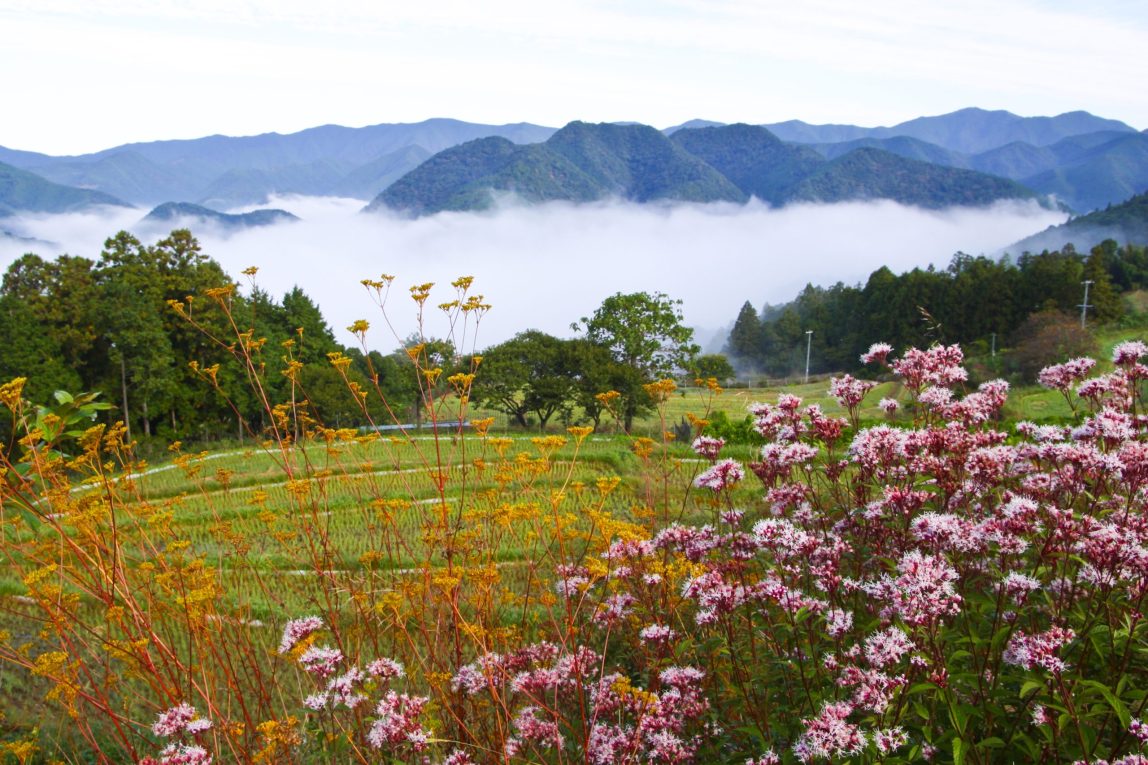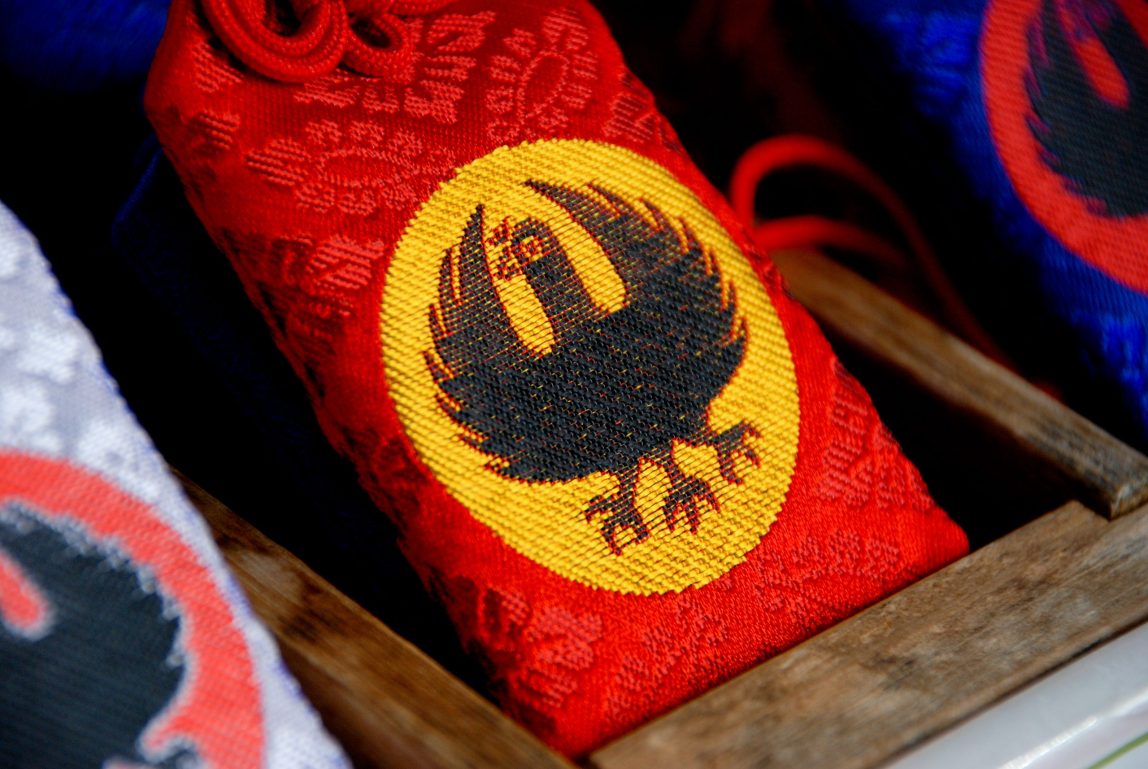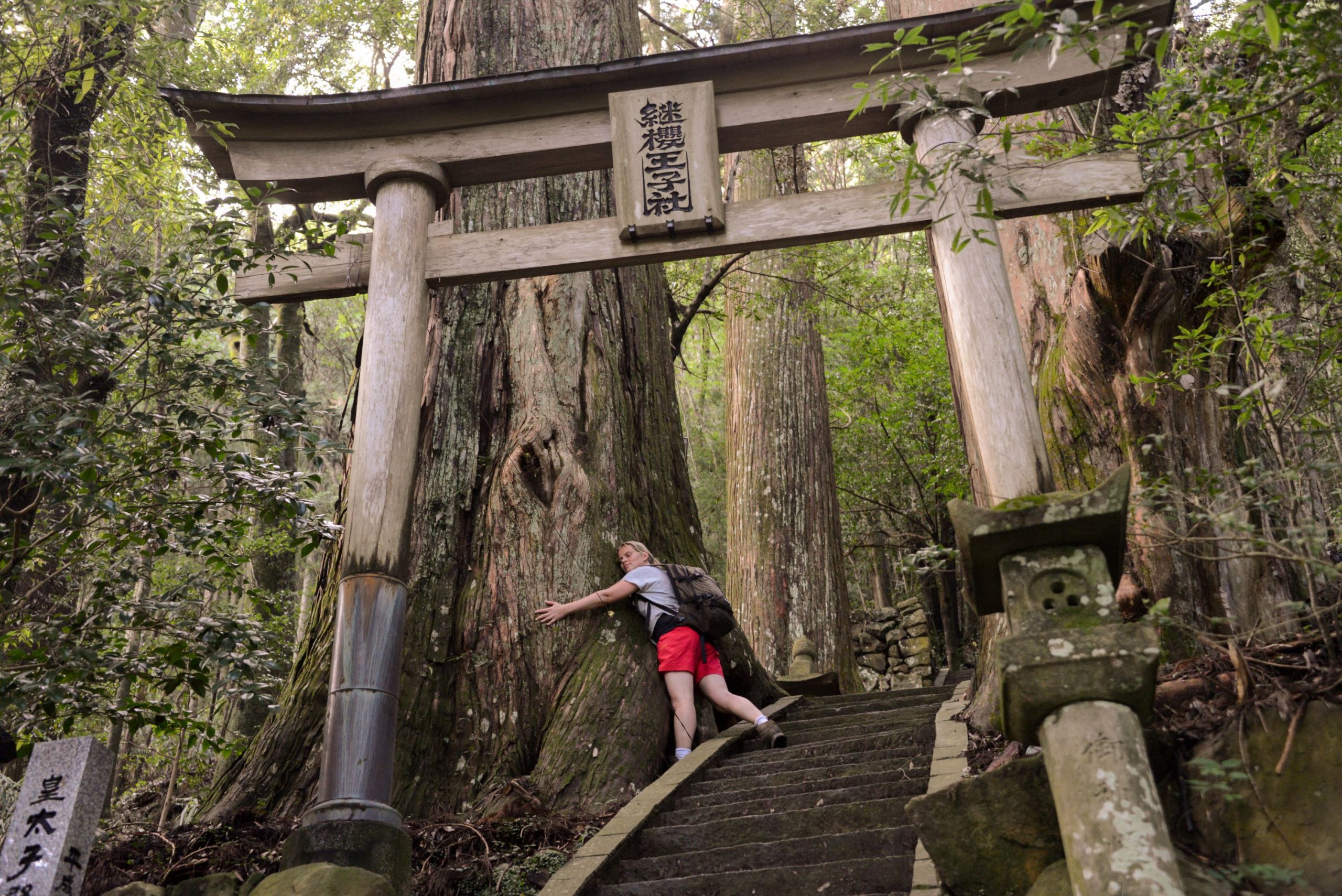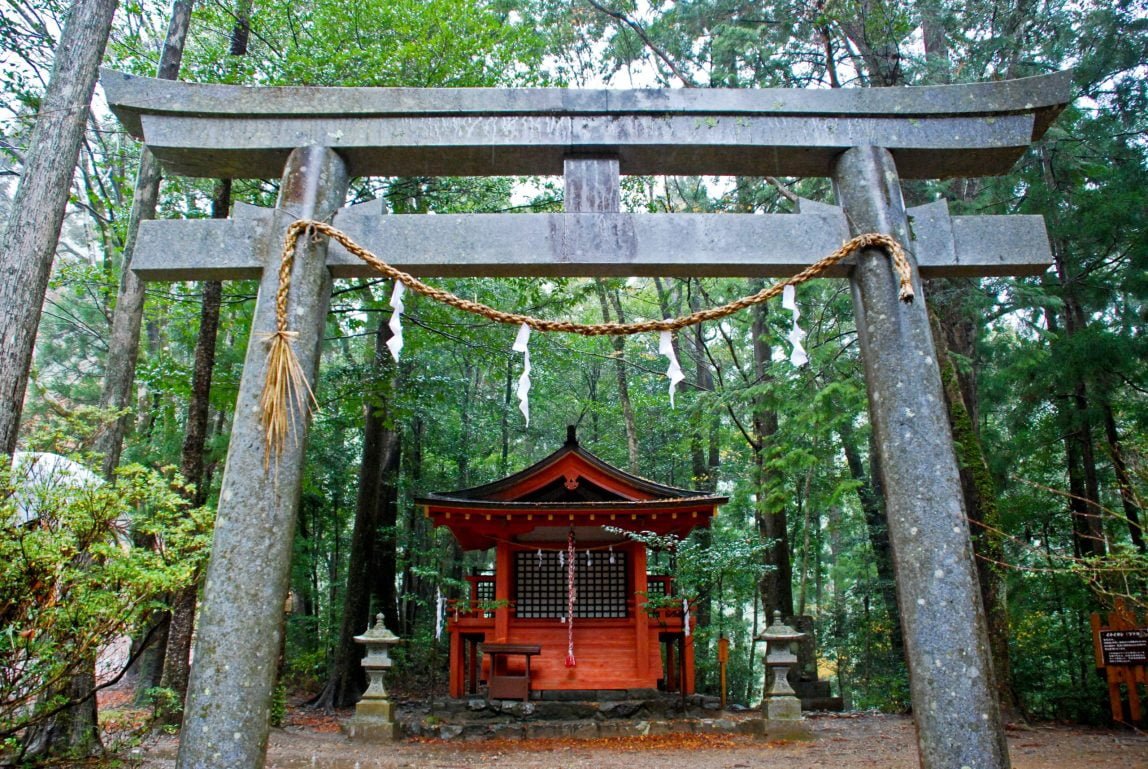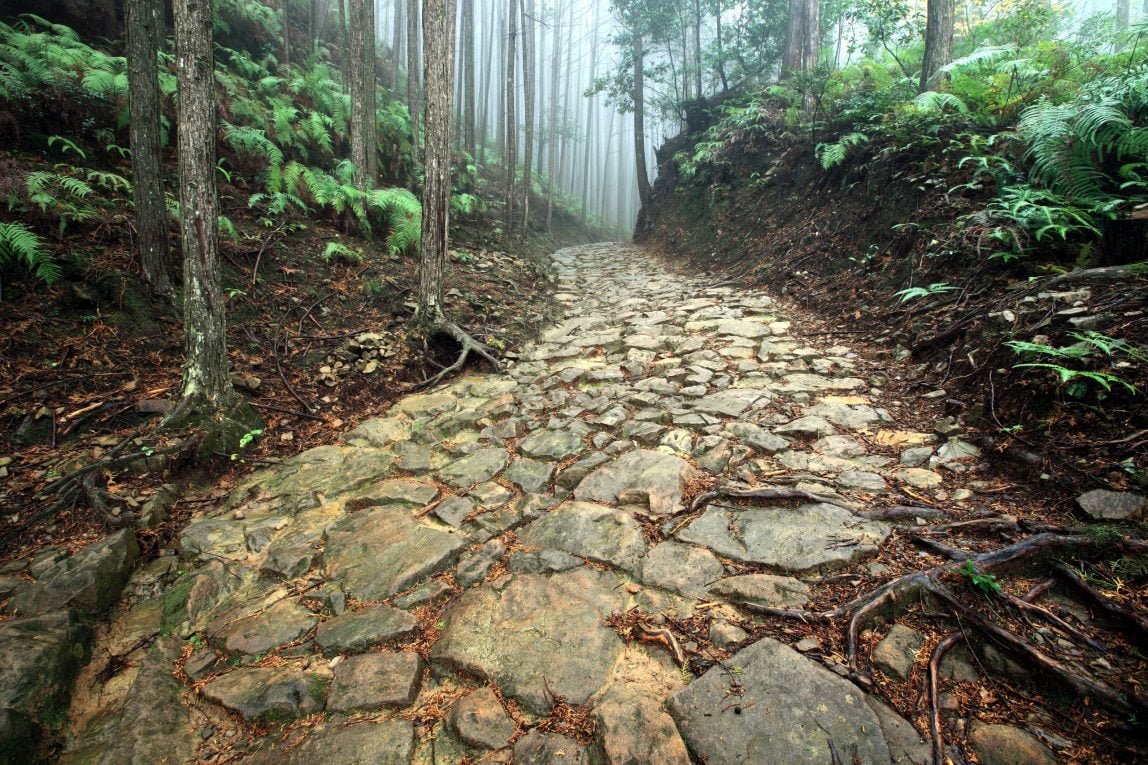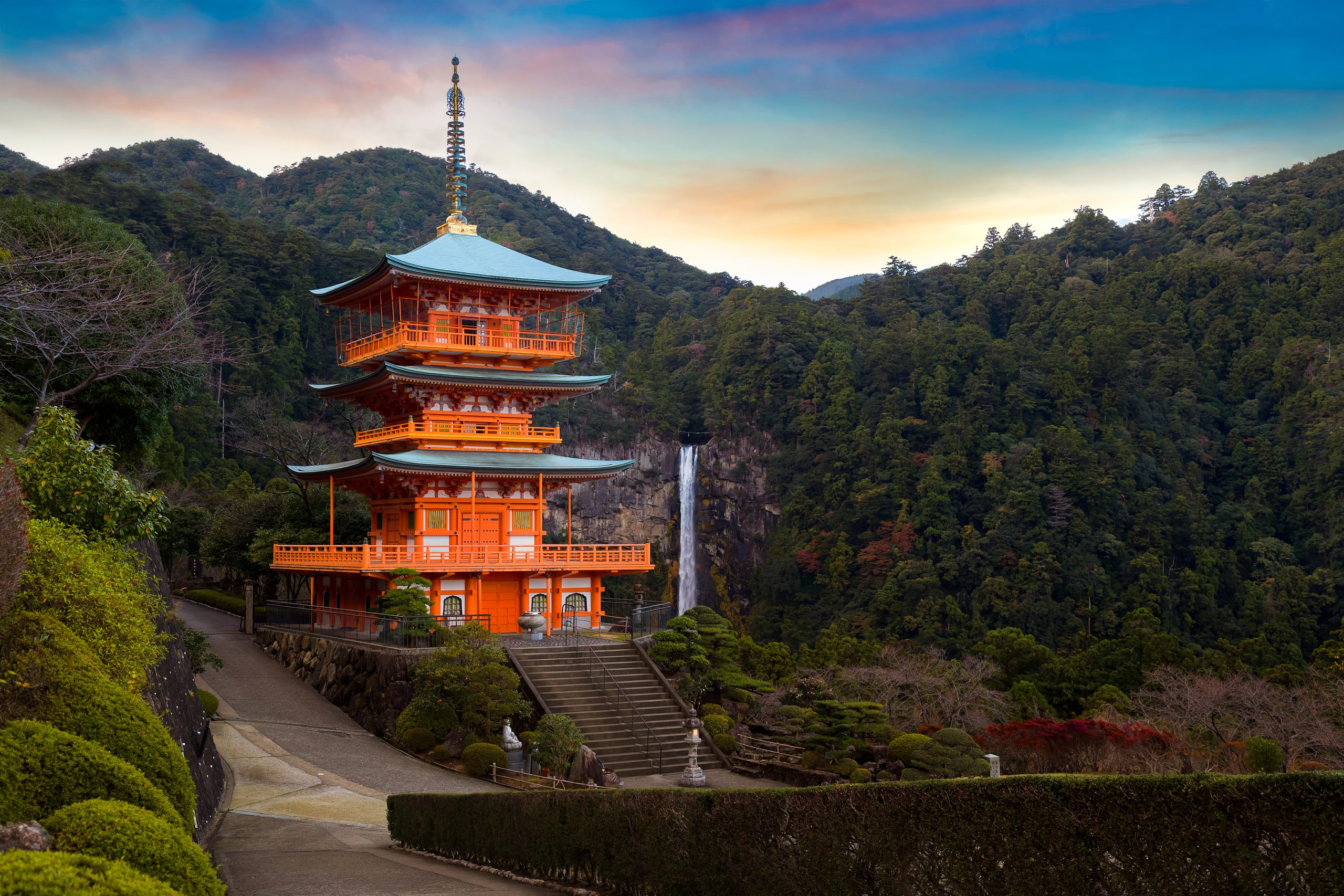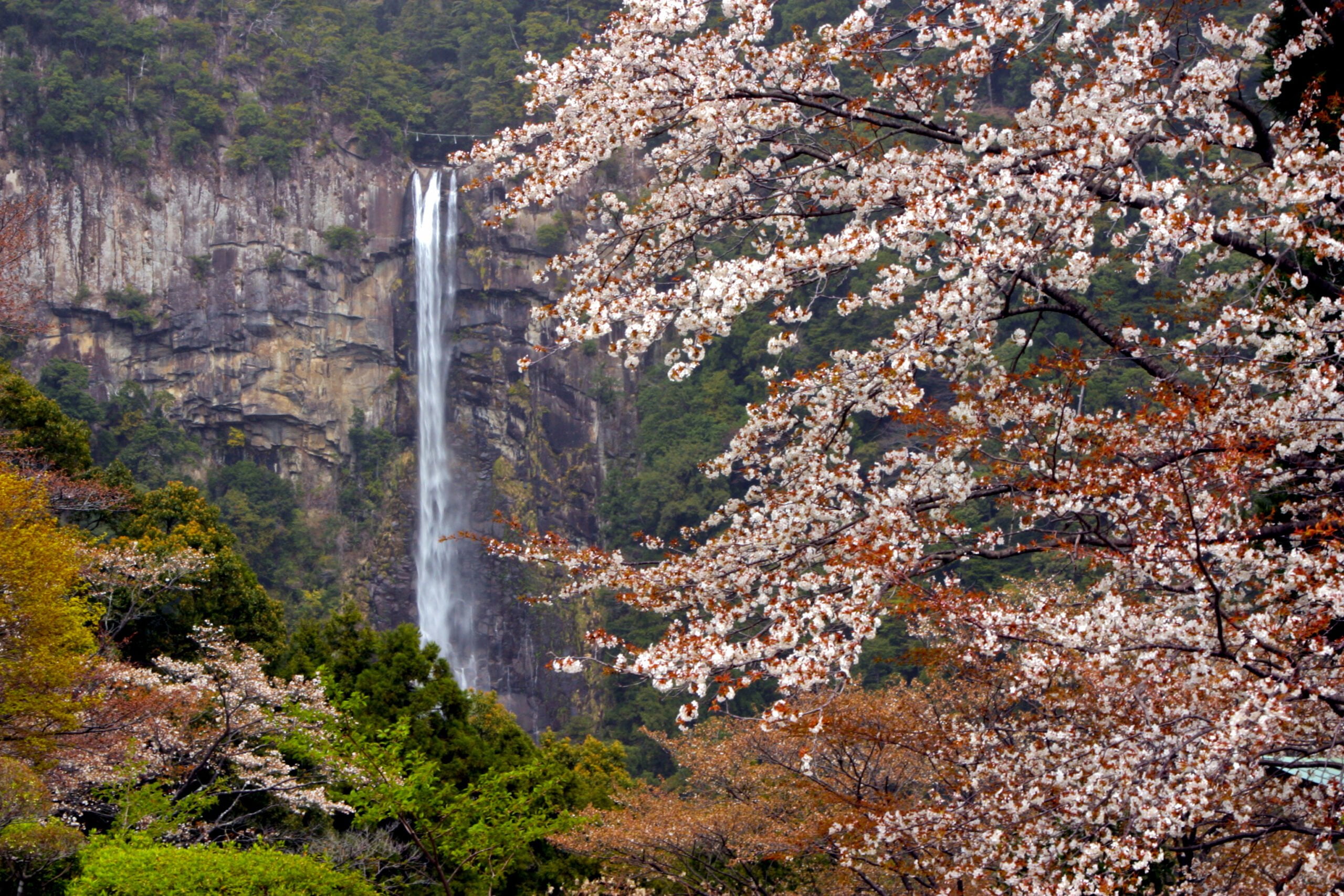 30 years' experience providing walking holidays worldwide
30 years' experience providing walking holidays worldwide-
SELF-GUIDED
-
10 DAYS
-
Moderate to Challenging
OVERVIEW
OVERVIEW
Hike along the Choishi Stupa route to Koyasan and the full Kumano Kodo Nakahechi as it cuts its way through beautiful mountains, forest and small villages, and to beautiful Japanese temples inhabited by monks. Soak in onsens while staying in authentic Japanese accommodation, savouring elaborate traditional Japanese dinners and breakfasts.
The visit to the spiritual capital of Shingon Buddhism in Japan and the world heritage-listed Koyasan set the tone for this walk. Koyasan, located at the top of Mount Koya, is famous not only for its stunning temples but also for its natural beauty. It is an ancient town that marks the end of the Kumano Kodo Kohechi route.
HIGHLIGHTS:
- Walk both Koyasan and the 1200-year-old world heritage-listed Kumano Kodo Nakahechi route at a slower pace
- 2-night stay in a Koyasan Buddhist temple and participate (if you wish to!) in the temple morning rituals
- Excellent graded trails, wondrous views, old forest, and opportunities to bathe in onsens
- Passing a multitude of ancient shrines and glorious temples
- Mountain and river-side walking with spectacular views
- The beautiful spectacle of Nachi waterfall, the tallest in Japan
- Walk toward becoming a dual pilgrim by walking the Kumano Kodo (the other world heritage-listed walk is the Camino de Santiago)
ITINERARY
WHAT’S INCLUDED
- Walk the entire Kumano Kodo Nakahechi from end to end over via magnificent shrines ending at the glorious Nachi waterfall and temple complex, plus substantial pilgrimage walks to Koyasan
- Walk pack free with luggage transfers from accommodation to accommodation
- 7 nights stay in an intimate family-run or smallish traditional Japanese lodgings, some with in-house onsens, and 2 nights in a Buddhist temple in Koyasan
- Superb traditional Japanese multi-course meals for breakfast and dinner on each walking day, plus 5 walkers lunches
- Itineraries can be flexible to shorten the walking or slow the trip down by adding more rest days
- Enjoy worry-free navigation with Stroll’s comprehensive track notes and maps
- On the ground support from local representatives
ACCOMMODATION & DINING
A real highlight is staying In Koyasan in a Buddhist temple, a truly different experience to our standard accommodation. Staff are very accustomed to receiving guests, with most of the temples being run like small hotels. A traditional Japanese breakfast and dinner will be supplied each day.
On the Kumano Kodo Nakahechi you will spend each night in a traditional Japanese Minshuku or Ryokan-style accommodation. These Japanese guesthouses come in a number of styles ranging from traditional wooden structures to more modern hybrid hotels.
A Minshuku is a family-run accommodation that are often found in rural Japan. There is a fine line between a Minshuku and some smaller Ryokans, making it hard to distinguish between the two. Most Minshukus are very small, with only a few Japanese-style rooms, a bit like a Bed and Breakfast Japanese style. Staying at a Minshuku has its advantages, as it is a good chance to meet the local people and get right up close to the Japanese culture. The atmosphere is often like that of a home with traditional meals served much like at a Ryokan but with even more intimacy. Be prepared, as baths and toilets are often shared.
Ryokans have Japanese-style rooms with tatami mats, shoji sliding doors, and futons for sleeping on. Few Ryokan Hotels have rooms with actual beds. The rooms may or may not have ensuites, but be prepared for a little luxury when it comes to the heated toilet seats. The bathing area is often the pride of the Ryokan, especially when they’re located in an onsen area. These are usually communal and separated by gender.
Meals are elaborate affairs from a western point of view served in a traditional dining area. A traditional Kaiseki set meal is what is usually offered. Sometimes there is the option of a buffet at the larger Ryokans.
Please note that we will endeavour to book the accommodation displayed. However, if unavailable, we will book alternative accommodation at the same standard.
GENERAL INFO
AVAILABILITY
This walk is available all year round, but you may encounter some snow from December to February. Many people prefer to walk in spring to see the cherry blossoms and in autumn because of the change of seasons and the good weather.
HIGH SEASON
In Japan, there are some periods when locals travel en masse as they are on holiday. These times are best avoided as the accommodation costs escalate considerably (more than double). It would make a lot of sense if you could avoid these times. Otherwise, see below for high-season periods. This could lead to the cost of the trip increasing by 30% or more.
NEW YEAR PERIOD – 30TH DECEMBER TO 4TH OF JANUARY
GOLDEN WEEK – GENERALLY BETWEEN 29TH APRIL TO 5TH MAY
OBON PERIOD – MID-AUGUST ( BETWEEN THE 10TH TO 20TH OF AUGUST)
Please speak to the office to get a quote for the above times
PUBLIC TRANSPORT
On this walk, you will have to catch at least 3 buses; most of the rides are very short. These cannot be pre-booked and are by far the best way to get around the mountains. These bus fares are at your own cost.
HOW TO GET THERE AND AWAY
Travelling to the Start of the walk
The first part of this walk starts in Koyasan on Mount Koya. You will need to get yourself to and from the start and end of your walk (i.e. you will need to organise your travel to the start of the walk in Koyasan and then onwards from your last accommodation).
From Koyasan you will travel to Tanabe and the walk ends in Nachi-san or Nachi-Katsuura. To make it easy we have collated some useful information that will assist you in making arrangements for your travel.
By Air: By far, the best option is to fly into Osaka and take the train from there. You can take the train direct from Osaka Kansai Airport to Koyasan. The train station is at the airport, and there are English speaking staff at the ticket office. The train ticket You might consider spending some time in Osaka. Osaka is a very interesting city and has many beautiful temples and of course Osaka Castle. In spring it is particularly beautiful. It also has a sophisticated restaurant culture and markets that seem to go on for kilometres, literally.
By rail: Japan has one of the best train systems in the world, so it’s very easy to catch a train to any destination in the country. An express train is the fastest way to travel to the area. Travelling in Japan on trains is a seamless experience, and it is not necessary to always pre-purchase tickets. There’s plenty of Rail staff that speak English well enough to direct you the right way and to converse with you about how to buy your ticket. We can provide more information if you wish, so please ask one of our destination consultants. However, Hyperdia is easily the best resource when planning your train travel in Japan.
This sounds complicated, but it is not and is all part of the adventure; normally you will need to buy just two tickets for the whole journey. You will need to get from Osaka to Shin-Imamiya Station on the Osaka Loop Line, There are 5 limited express trains per day that will take you directly to Gokurakubashi on the Nankai line (not a JR line). It is also possible to take an express or rapid train (departure every 20-30 minutes) that will take you to Hashimoto in less than two hours, from there you will have to take a local train to reach Gokurakubashi.
From this station, the Koyasan (Mount Koya) cable car will take you to the Koyasan stop for YEN390 for a 5-minute journey. Once off the cable car, you will be directed by a conductor onto the right bus (not part of the ticket) for your accommodation (see day by day summary) for a 10 minutes ride to Koyasan Senjuinbashi and your accommodation.
Hyperdia is a great website resource to figure out when and where your train departs. It might be best to buy your train ticket on the JR train network when you first arrive in Japan so you can relax. However, the trains run often and are so efficient that you shouldn’t have any trouble just arriving 20 minutes beforehand and buying a ticket. JR passes can be a convenient and reasonable way to get around the area. There are two regional JR passes that cover the Kii Peninsula: Kansai WIDE Area Pass, and Ise-Kumano-Wakayama Area Tourist Pass.
Getting to Kii Tanabe and the Kumano Koda from Koyasan
By rail: Much the same as getting there, take the cable car and Nankai Railway from Koyasan to Hashimoto (one hour) and transfer to the JR Wakayama Line onto Wakayama Station (about one hour). From Wakayama, take a limited express train along the JR Kinokuni Line (aka Kisei Line) down the coast to the Kumano region (80 minutes to Shirahama, 2 hours to Tanabe). The one-way fare from Hashimoto to Tanabe is around YEN4,500.
By local buses through the mountains via Ryujin Onsen (no service in winter)
From April through November, there are one or two bus connections per day from Koyasan to Gomadanzan, from where it is possible to continue to Kii-Tanabe Station or Hongu Taisha. The entire one way trip between Koyasan and Kii-Tanabe Station takes around 3.5 hours and costs about YEN5,000. During winter, there is no bus service between Koyasan and Ryujin Onsen. Please ask at the information centre as per the details to what time it leaves (it was 9:45 am the last time we checked, please let us know if this has changed). The bus departs from outside the Koyasan Tourism Association Central near the Takano Post Office and the Koyacho Fire Department (near the Koyasan University).
Travelling from the end of the walk
By rail: The train from Katsuura (Kii- Katsuura train station is a short distance from Nachisan) back to Osaka takes about 4 hours and costs about YEN4,700. You can also choose to go to Tokyo or anywhere else for that matter in Japan. However, you most likely will need to travel through a major city to get there.
By Air: See above
WALKING
The walk is moderate to moderate to challenging with some long days if you wish. Full-day walks average about 17 km with 5 –9 hours walking each day however they can be as long as 24kms (You can shorten most days). The walking is over well-maintained paths, but expect each day to start with some reasonable elevation gains. All good though as the tracks do flatten out.
This is a historic route with stacks of small temples (Oji) and statues to admire along the way. For much of the time you are walking under forest canopy which makes for mild conditions other than the height of summer.
For what to bring please refer to Gear Advice on our FAQ section.
WEATHER
From the end of March, the temperature begins to increase. In summer it’s quite warm and humid but still good for walking, particularly if you enjoy warmer temperatures and taking a dip in a stream.
The walk is offered in winter but bring some warm clothes and good rain gear. The area is just as beautiful if not more and is not busy at all. Soaking in outside onsen in the cool of the night is one of those real authentic Japanese experiences that you can look forward to after a big day on the track.
As walkers, we believe spring and autumn to be the best time as the weather is perfect for walking.
See the weather information about Osaka’s average weather at different times of the year.
INSURANCE
We require that you have adequate travel insurance against potential losses, damage or injury, including cancellation costs and loss of luggage.
For all trips that require international travel, you must have purchased travel insurance that also includes medical evacuation coverage.
We also charge a cancellation fee if you cancel your walking holiday after we have confirmed it to cover costs incurred from our suppliers and in the office. See the FAQ section for more information.
INFORMATION PACK
For nearly 30 years we have taken pride in providing seamlessly organised walking holidays, but we know, even with that in mind, that you’ll have many more questions. You will receive a very detailed information pack and itinerary approximately 6 weeks out from departure outlining all the fine detail and much more.
CONTACT
If you have any questions, feel free to ask one of our destination consultants. You can get in touch with us via our contact form or email us at info@stroll.com
MAP
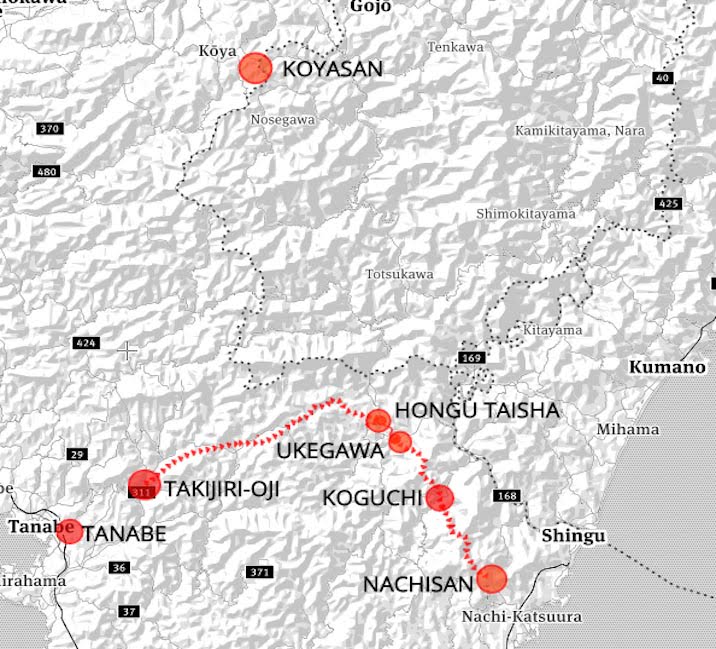
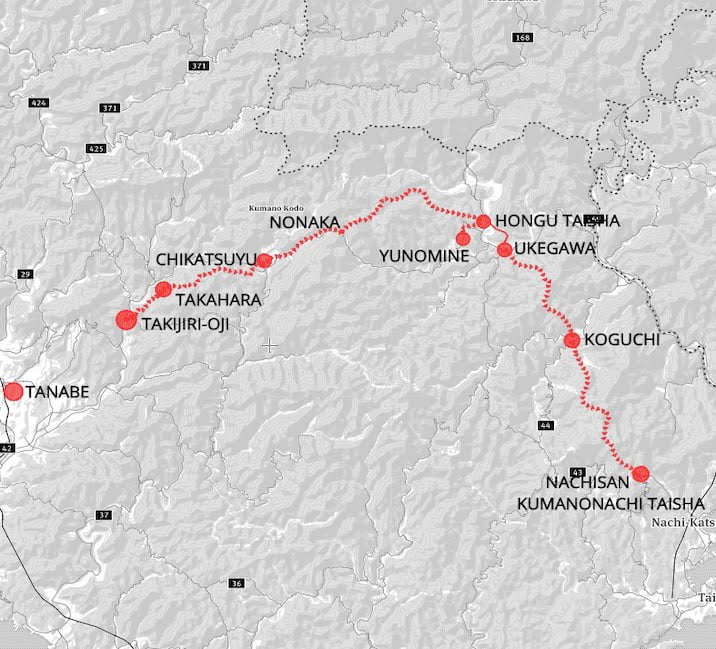
DEPARTURE DATES
-
DATESAVAILABILITYPRICESingle OccupancyDetails
-
1 Jun 2024 - 31 Jul 2024AVAILABLE
from £ 1695
SINGLE OCCUPANCY£ 135 -
1 Aug 2024 - 31 Dec 2024AVAILABLE
from £ 2000
SINGLE OCCUPANCY£ 150 -
1 Jan 2025 - 28 Feb 2025AVAILABLE
from £ 1750
SINGLE OCCUPANCY£ 145 -
1 Mar 2025 - 31 May 2025AVAILABLE
from £ 2025
SINGLE OCCUPANCY£ 160 -
1 Jun 2025 - 31 Jul 2025AVAILABLE
from £ 1750
SINGLE OCCUPANCY£ 145 -
1 Aug 2025 - 31 Dec 2025AVAILABLE
from £ 2025
SINGLE OCCUPANCY£ 160 -
1 Jan 2026 - 28 Feb 2026AVAILABLE
from £ 1820
SINGLE OCCUPANCY£ 150 -
1 Mar 2026 - 31 May 2026AVAILABLE
from £ 2105
SINGLE OCCUPANCY£ 165 -
1 Jun 2026 - 31 Jul 2026AVAILABLE
from £ 1820
SINGLE OCCUPANCY£ 150 -
1 Aug 2026 - 31 Dec 2026AVAILABLE
from £ 2105
SINGLE OCCUPANCY£ 165
sections
Hike along the Choishi Stupa route to Koyasan and the full Kumano Kodo Nakahechi as it cuts its way through beautiful mountains, forest and small villages, and to beautiful Japanese temples inhabited by monks. Soak in onsens while staying in authentic Japanese accommodation, savouring elaborate traditional Japanese dinners and breakfasts.
The visit to the spiritual capital of Shingon Buddhism in Japan and the world heritage-listed Koyasan set the tone for this walk. Koyasan, located at the top of Mount Koya, is famous not only for its stunning temples but also for its natural beauty. It is an ancient town that marks the end of the Kumano Kodo Kohechi route.
HIGHLIGHTS:
- Walk both Koyasan and the 1200-year-old world heritage-listed Kumano Kodo Nakahechi route at a slower pace
- 2-night stay in a Koyasan Buddhist temple and participate (if you wish to!) in the temple morning rituals
- Excellent graded trails, wondrous views, old forest, and opportunities to bathe in onsens
- Passing a multitude of ancient shrines and glorious temples
- Mountain and river-side walking with spectacular views
- The beautiful spectacle of Nachi waterfall, the tallest in Japan
- Walk toward becoming a dual pilgrim by walking the Kumano Kodo (the other world heritage-listed walk is the Camino de Santiago)
- Walk the entire Kumano Kodo Nakahechi from end to end over via magnificent shrines ending at the glorious Nachi waterfall and temple complex, plus substantial pilgrimage walks to Koyasan
- Walk pack free with luggage transfers from accommodation to accommodation
- 7 nights stay in an intimate family-run or smallish traditional Japanese lodgings, some with in-house onsens, and 2 nights in a Buddhist temple in Koyasan
- Superb traditional Japanese multi-course meals for breakfast and dinner on each walking day, plus 5 walkers lunches
- Itineraries can be flexible to shorten the walking or slow the trip down by adding more rest days
- Enjoy worry-free navigation with Stroll’s comprehensive track notes and maps
- On the ground support from local representatives
A real highlight is staying In Koyasan in a Buddhist temple, a truly different experience to our standard accommodation. Staff are very accustomed to receiving guests, with most of the temples being run like small hotels. A traditional Japanese breakfast and dinner will be supplied each day.
On the Kumano Kodo Nakahechi you will spend each night in a traditional Japanese Minshuku or Ryokan-style accommodation. These Japanese guesthouses come in a number of styles ranging from traditional wooden structures to more modern hybrid hotels.
A Minshuku is a family-run accommodation that are often found in rural Japan. There is a fine line between a Minshuku and some smaller Ryokans, making it hard to distinguish between the two. Most Minshukus are very small, with only a few Japanese-style rooms, a bit like a Bed and Breakfast Japanese style. Staying at a Minshuku has its advantages, as it is a good chance to meet the local people and get right up close to the Japanese culture. The atmosphere is often like that of a home with traditional meals served much like at a Ryokan but with even more intimacy. Be prepared, as baths and toilets are often shared.
Ryokans have Japanese-style rooms with tatami mats, shoji sliding doors, and futons for sleeping on. Few Ryokan Hotels have rooms with actual beds. The rooms may or may not have ensuites, but be prepared for a little luxury when it comes to the heated toilet seats. The bathing area is often the pride of the Ryokan, especially when they’re located in an onsen area. These are usually communal and separated by gender.
Meals are elaborate affairs from a western point of view served in a traditional dining area. A traditional Kaiseki set meal is what is usually offered. Sometimes there is the option of a buffet at the larger Ryokans.
Please note that we will endeavour to book the accommodation displayed. However, if unavailable, we will book alternative accommodation at the same standard.
AVAILABILITY
This walk is available all year round, but you may encounter some snow from December to February. Many people prefer to walk in spring to see the cherry blossoms and in autumn because of the change of seasons and the good weather.
HIGH SEASON
In Japan, there are some periods when locals travel en masse as they are on holiday. These times are best avoided as the accommodation costs escalate considerably (more than double). It would make a lot of sense if you could avoid these times. Otherwise, see below for high-season periods. This could lead to the cost of the trip increasing by 30% or more.
NEW YEAR PERIOD – 30TH DECEMBER TO 4TH OF JANUARY
GOLDEN WEEK – GENERALLY BETWEEN 29TH APRIL TO 5TH MAY
OBON PERIOD – MID-AUGUST ( BETWEEN THE 10TH TO 20TH OF AUGUST)
Please speak to the office to get a quote for the above times
PUBLIC TRANSPORT
On this walk, you will have to catch at least 3 buses; most of the rides are very short. These cannot be pre-booked and are by far the best way to get around the mountains. These bus fares are at your own cost.
HOW TO GET THERE AND AWAY
Travelling to the Start of the walk
The first part of this walk starts in Koyasan on Mount Koya. You will need to get yourself to and from the start and end of your walk (i.e. you will need to organise your travel to the start of the walk in Koyasan and then onwards from your last accommodation).
From Koyasan you will travel to Tanabe and the walk ends in Nachi-san or Nachi-Katsuura. To make it easy we have collated some useful information that will assist you in making arrangements for your travel.
By Air: By far, the best option is to fly into Osaka and take the train from there. You can take the train direct from Osaka Kansai Airport to Koyasan. The train station is at the airport, and there are English speaking staff at the ticket office. The train ticket You might consider spending some time in Osaka. Osaka is a very interesting city and has many beautiful temples and of course Osaka Castle. In spring it is particularly beautiful. It also has a sophisticated restaurant culture and markets that seem to go on for kilometres, literally.
By rail: Japan has one of the best train systems in the world, so it’s very easy to catch a train to any destination in the country. An express train is the fastest way to travel to the area. Travelling in Japan on trains is a seamless experience, and it is not necessary to always pre-purchase tickets. There’s plenty of Rail staff that speak English well enough to direct you the right way and to converse with you about how to buy your ticket. We can provide more information if you wish, so please ask one of our destination consultants. However, Hyperdia is easily the best resource when planning your train travel in Japan.
This sounds complicated, but it is not and is all part of the adventure; normally you will need to buy just two tickets for the whole journey. You will need to get from Osaka to Shin-Imamiya Station on the Osaka Loop Line, There are 5 limited express trains per day that will take you directly to Gokurakubashi on the Nankai line (not a JR line). It is also possible to take an express or rapid train (departure every 20-30 minutes) that will take you to Hashimoto in less than two hours, from there you will have to take a local train to reach Gokurakubashi.
From this station, the Koyasan (Mount Koya) cable car will take you to the Koyasan stop for YEN390 for a 5-minute journey. Once off the cable car, you will be directed by a conductor onto the right bus (not part of the ticket) for your accommodation (see day by day summary) for a 10 minutes ride to Koyasan Senjuinbashi and your accommodation.
Hyperdia is a great website resource to figure out when and where your train departs. It might be best to buy your train ticket on the JR train network when you first arrive in Japan so you can relax. However, the trains run often and are so efficient that you shouldn’t have any trouble just arriving 20 minutes beforehand and buying a ticket. JR passes can be a convenient and reasonable way to get around the area. There are two regional JR passes that cover the Kii Peninsula: Kansai WIDE Area Pass, and Ise-Kumano-Wakayama Area Tourist Pass.
Getting to Kii Tanabe and the Kumano Koda from Koyasan
By rail: Much the same as getting there, take the cable car and Nankai Railway from Koyasan to Hashimoto (one hour) and transfer to the JR Wakayama Line onto Wakayama Station (about one hour). From Wakayama, take a limited express train along the JR Kinokuni Line (aka Kisei Line) down the coast to the Kumano region (80 minutes to Shirahama, 2 hours to Tanabe). The one-way fare from Hashimoto to Tanabe is around YEN4,500.
By local buses through the mountains via Ryujin Onsen (no service in winter)
From April through November, there are one or two bus connections per day from Koyasan to Gomadanzan, from where it is possible to continue to Kii-Tanabe Station or Hongu Taisha. The entire one way trip between Koyasan and Kii-Tanabe Station takes around 3.5 hours and costs about YEN5,000. During winter, there is no bus service between Koyasan and Ryujin Onsen. Please ask at the information centre as per the details to what time it leaves (it was 9:45 am the last time we checked, please let us know if this has changed). The bus departs from outside the Koyasan Tourism Association Central near the Takano Post Office and the Koyacho Fire Department (near the Koyasan University).
Travelling from the end of the walk
By rail: The train from Katsuura (Kii- Katsuura train station is a short distance from Nachisan) back to Osaka takes about 4 hours and costs about YEN4,700. You can also choose to go to Tokyo or anywhere else for that matter in Japan. However, you most likely will need to travel through a major city to get there.
By Air: See above
WALKING
The walk is moderate to moderate to challenging with some long days if you wish. Full-day walks average about 17 km with 5 –9 hours walking each day however they can be as long as 24kms (You can shorten most days). The walking is over well-maintained paths, but expect each day to start with some reasonable elevation gains. All good though as the tracks do flatten out.
This is a historic route with stacks of small temples (Oji) and statues to admire along the way. For much of the time you are walking under forest canopy which makes for mild conditions other than the height of summer.
For what to bring please refer to Gear Advice on our FAQ section.
WEATHER
From the end of March, the temperature begins to increase. In summer it’s quite warm and humid but still good for walking, particularly if you enjoy warmer temperatures and taking a dip in a stream.
The walk is offered in winter but bring some warm clothes and good rain gear. The area is just as beautiful if not more and is not busy at all. Soaking in outside onsen in the cool of the night is one of those real authentic Japanese experiences that you can look forward to after a big day on the track.
As walkers, we believe spring and autumn to be the best time as the weather is perfect for walking.
See the weather information about Osaka’s average weather at different times of the year.
INSURANCE
We require that you have adequate travel insurance against potential losses, damage or injury, including cancellation costs and loss of luggage.
For all trips that require international travel, you must have purchased travel insurance that also includes medical evacuation coverage.
We also charge a cancellation fee if you cancel your walking holiday after we have confirmed it to cover costs incurred from our suppliers and in the office. See the FAQ section for more information.
INFORMATION PACK
For nearly 30 years we have taken pride in providing seamlessly organised walking holidays, but we know, even with that in mind, that you’ll have many more questions. You will receive a very detailed information pack and itinerary approximately 6 weeks out from departure outlining all the fine detail and much more.
CONTACT
If you have any questions, feel free to ask one of our destination consultants. You can get in touch with us via our contact form or email us at info@stroll.com
-
DATESAVAILABILITYPRICESingle OccupancyDETAILS
-
Date1 Jun 2024 - 31 Jul 2024AVAILIBILITYAVAILABLEPRICEfrom £ 1695SINGLE OCCUPANCY£ 135DETAILS
-
Date1 Aug 2024 - 31 Dec 2024AVAILIBILITYAVAILABLEPRICEfrom £ 2000SINGLE OCCUPANCY£ 150DETAILS
-
Date1 Jan 2025 - 28 Feb 2025AVAILIBILITYAVAILABLEPRICEfrom £ 1750SINGLE OCCUPANCY£ 145DETAILS
-
Date1 Mar 2025 - 31 May 2025AVAILIBILITYAVAILABLEPRICEfrom £ 2025SINGLE OCCUPANCY£ 160DETAILS
-
Date1 Jun 2025 - 31 Jul 2025AVAILIBILITYAVAILABLEPRICEfrom £ 1750SINGLE OCCUPANCY£ 145DETAILS
-
Date1 Aug 2025 - 31 Dec 2025AVAILIBILITYAVAILABLEPRICEfrom £ 2025SINGLE OCCUPANCY£ 160DETAILS
-
Date1 Jan 2026 - 28 Feb 2026AVAILIBILITYAVAILABLEPRICEfrom £ 1820SINGLE OCCUPANCY£ 150DETAILS
-
Date1 Mar 2026 - 31 May 2026AVAILIBILITYAVAILABLEPRICEfrom £ 2105SINGLE OCCUPANCY£ 165DETAILS
-
Date1 Jun 2026 - 31 Jul 2026AVAILIBILITYAVAILABLEPRICEfrom £ 1820SINGLE OCCUPANCY£ 150DETAILS
-
Date1 Aug 2026 - 31 Dec 2026AVAILIBILITYAVAILABLEPRICEfrom £ 2105SINGLE OCCUPANCY£ 165DETAILS





